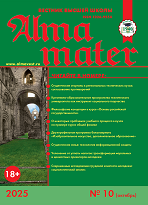UDC 378:37/09:81
https://doi.org/10.20339/AM.02-22.063
Lucia M. Nurieva, Candidate of Pedagogical Sciences, Associate Professor of the Department of Mathematics and Methods of Teaching Mathematics of Omsk State Pedagogical University, e-mail: liutsiya59@mail.ru
Sergey G. Kiselev, sociologist of the Center for Adaptation and Employment of Students and Graduates of Omsk State Pedagogical University, e-mail: ksg_sd@mail.ru
Acute disproportions between the structure of training of highly qualified personnel and requests from employers for specialists with higher education have been preserved for a long time in the labor market of the Omsk region. One of the reasons for these imbalances is the emigration of graduates of Omsk universities, which has become the object of study in this work. The scale of emigration of graduates from the Omsk region has acquired such a scale that, compared with almost all the territories of Russia, the region has a negative balance in the field of arrival and departure of young specialists. The empirical material of the study was the monitoring of the employment of graduates of institutions of higher professional education, which was conducted by the Ministry of Education and Science of the Russian Federation in 2013–2015 on its specialized portal. The results of employment of graduates of Omsk universities in specialties, directions and scales of emigration from the region within the gravitational concept of migration are considered. It is shown that the directions of emigration of graduates are associated with the level of socio-economic development of the host regions. The main characteristics when choosing employment places for migrant graduates are indicators of social and financial well-being of certain territories. There are also significant differences in the remuneration of graduates depending on the region of employment. At the same time, it was found that the outflow of graduates from the Omsk region is associated not only with the difference in wages in the regions, but also with the lack of a sufficient number of satisfactory jobs in the local labor market.
Key words: employment of graduates, gravity model, migration, youth, labor market, Omsk region.
References
1. Adediran, A.M. Key milestones in the formation of the modern theory of migration in the works of Western scientists of the 20th century. Bulletin of RUDN Series: Sociology. 2015. No. 1. URL: https://cyberleninka.ru/article/n/klyuchevyevehistanovleniyasovremennoyt... (accessed on: 17.11.2021).
2. Antosik, L.V., Ivashina, N.V. Factors and Routes of Interregional Migration of University Graduates in Russia. Educational Studies Moscow. 2021. No. 2. Р. 107–125. URL: https://doi.org/10.17323/1814-9545-2021-2-107-125 (accessed on: 17.11.2021).
3.Varshavskaya, E.Ya., Chudinovskikh, O.S. Migration Intentions of Graduates of Russia’s Regional Higher Educational Institutions. Bulletin of Moscow University. Ser. Economy. 2014. No. 3. Р. 36–58. URL: https://www.econ.msu.ru/sys/raw.php?o=14958&p=attachment (accessed on: 17.11.2021).
4. Vasilenko, P.V. Gravitational forces and migration mobility of the regio’s population. Bulletin of the Baltic Federal University. I. Kant. 2013. Iss. 7. P. 155–159. URL: https://journals.kantiana.ru/upload/iblock/b05/Vasilenko%20P._153157.pdf (accessed on: 17.11.2021).
5. Vasilenko, P.V. Foreign theories of population migration. Pskov regionalological journal. 2013. No. 16. URL: https://cyberleninka.ru/article/n/zarubezhnyeteoriimigratsiinaseleniya (accessed on: 17.11.2021).
6. Guseinova, A.I., Kozlova, E.I. Classical and modern theories of population migration. Innovative Economy: Prospects for Development and Improvement. 2019. No. 2 (36). URL: https://cyberleninka.ru/article/n/klassicheskieisovremennyeteoriimigrats... (accessed on: 17.11.2021).
7. Ivakhnyuk, I.V. Development of migration theory in the context of globalization. Age of Globalization. 2015. No. 1. URL: https://cyberleninka.ru/article/n/razvitiemigratsionnoyteoriivusloviyahg... (accessed on: 17.11.2021).
8. Iontsev, V.A. International population migration: theory and history of study. Moscow: Dialogue of Moscow State University, 1999. 370 p. URL: http://www.doc.knigix.ru/22istoriya/ 794991vaioncevmezhdunarodnayamigraciyanaseleniyateoriyaistoriyaizucheniyavipuskmoskvadialogmgubbk.php (accessed on: 07.09.2021).
9. Klyucharev, G.A. “The gap” of education and the labor market: expert opinions. Sociological studies. 2015. No. 11. P. 49–56.
10. Kozlov, D.V., Platonova, D.P., Leshukov, O.V. Where to study and where to work: interregional mobility of university students and graduates. Modern analytics of education. 2017. No. 4 (12). URL: https://ioe.hse.ru/pubs/share/direct/408112802.pdf (accessed on: 17.11.2021).
11. Kozlova, E.V. Modern theories of international labor migration as a methodology for the development of domestic migration policy. Vestnik of Tomsk State University. Economy 2015. No. 2 (30). URL: https://cyberleninka.ru/article/n/sovremennyeteoriimezhdunarodnoytrudovo... (accessed on: 17.11.2021).
12. Perevedentsev, V.I. Methods of studying population migration. Moscow: Nauka, 1975 . 231 p. URL: http: //www.demoscope.ru/weekly/knigi/perevedencev/perevedencev.pdf, free (accessed on: 17.11.2021).
13. Tyutereva, A.R. Theoretical concepts of international labor migration. Innovative Science. 2016. № 22 (14). URL: https://cyberleninka.ru/article/n/teoreticheskiekontseptsiimezhdunarodno... (accessed on: 17.11.2021).
14. Fadeeva, I.M., Sofronov, D.A. Trajectories of interregional migrations of university graduates in the Volga Federal District. Proceedings of higher educational institutions. Volga region. Social Sciences. 2018. No. 1 (45). URL: https://cyberleninka.ru/article/n/traektorii-mezhregionalnyh-migratsiy-v... (accessed on: 10.11.2021).
15. Hot, Z.Z. Methodological approaches to the study of migration processes. Bulletin of the Adyghe State University. Ser. 1: Regional studies: philosophy, history, sociology, jurisprudence, political science, cultural studies. 2016. No. 4 (189). URL: https://cyberleninka.ru/article/n/metodologicheskiepodhodykizucheniyumig... (accessed on: 17.11.2021).
16. Bloomfield, A., Rose, B., Preston, A., Henneberger, A. Brain Drain in Maryland: Exploring Student Movement from High School to Postsecondary Education and the Workforce. The AIR Professional File. Fall 2020. Article 151. URL: http://eric.ed.gov/?id=ED610422
17. Hora, M. Hiring as cultural gatekeeping into occupational communities: Implications for college students, faculty, and career advisors. 2018 (WCER Working Paper No. 2018-1). URL: https://files.eric.ed.gov/fulltext/ED587790.pdf











.png)






